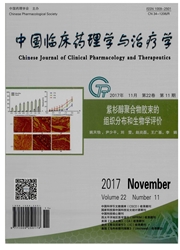

 中文摘要:
中文摘要:
目的:从大鼠血管平滑肌细胞凋亡角度探讨粉防己碱逆转肾血管性高血压血管重构的机制。方法:两肾-夹法制备肾性高血压模型,原位末端标记法检测主动脉和尾动脉动脉壁平滑肌细胞凋亡数量;[3H]-TdR掺入和流式细胞术分析粉防己碱对培养细胞凋亡率的影响。结果:粉防己碱能够诱导血管平滑肌细胞凋亡,并使低血清和TNFα、转化生长因子(TGFβ1)诱导的细胞凋亡率增加。结论:粉防己碱逆转肾性高血压大鼠(RHR)血管重构的机制可能与诱导和敏化RHR血管平滑肌细胞凋亡有关。
 英文摘要:
英文摘要:
AIM: To determine whether apoptosis is involved in the development of vascular remodeling in renovascular hypertension mrs and whether the inhibitory effect of tetrandrine on proliferation is mediated by apoptosis. METHODS: Apoptosis was detected in histologic sections of aorta and tail arteries with in situ end-labeling. The apoptosis ratio in cultured cells was measured by [^3H]-TdR incorporation and flow cytometer analysis method. RESULTS: Compared with the sham group, the apoptosis rate of renal hypertension rat (RHR) increased. Tetrandrine (Tet) directly induced apoptosis in cultured AVSMCs (from RHR) and increased apoptosis induced by TGFα, TGFβ1 and deficient FCS. CONCLUSION: Tet induces and sensitizes vascular smooth muscle ceils of RHR to apoptosis, which at least partly related to the regression of vascular remodeling.
 同期刊论文项目
同期刊论文项目
 同项目期刊论文
同项目期刊论文
 期刊信息
期刊信息
